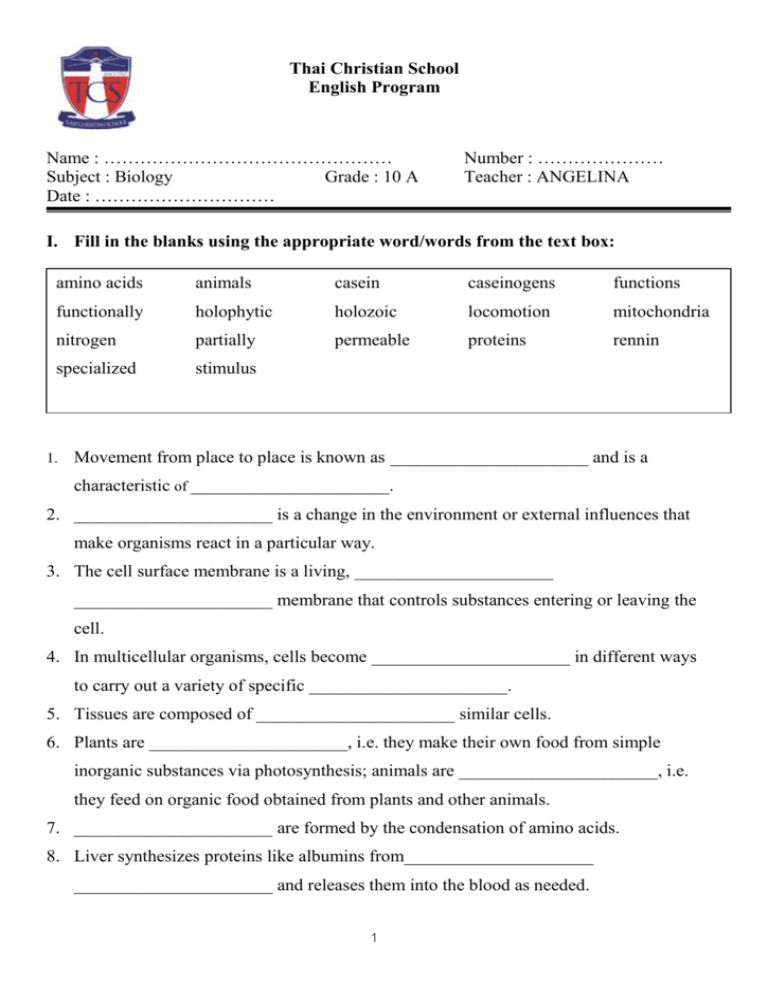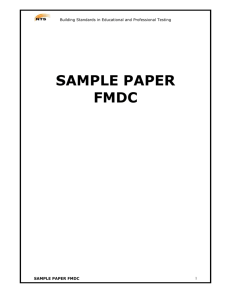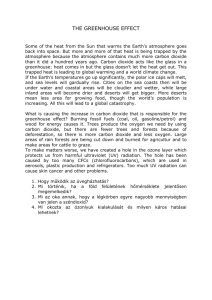Flood review worksheet G 10 science
advertisement

Thai Christian School English Program Name : ………………………………………… Subject : Biology Grade : 10 A Date : ………………………… Number : ………………… Teacher : ANGELINA I. Fill in the blanks using the appropriate word/words from the text box: amino acids animals casein caseinogens functions functionally holophytic holozoic locomotion mitochondria nitrogen partially permeable proteins rennin specialized stimulus 1. Movement from place to place is known as ______________________ and is a characteristic of ______________________. 2. ______________________ is a change in the environment or external influences that make organisms react in a particular way. 3. The cell surface membrane is a living, ______________________ ______________________ membrane that controls substances entering or leaving the cell. 4. In multicellular organisms, cells become ______________________ in different ways to carry out a variety of specific ______________________. 5. Tissues are composed of ______________________ similar cells. 6. Plants are ______________________, i.e. they make their own food from simple inorganic substances via photosynthesis; animals are ______________________, i.e. they feed on organic food obtained from plants and other animals. 7. ______________________ are formed by the condensation of amino acids. 8. Liver synthesizes proteins like albumins from_____________________ ______________________ and releases them into the blood as needed. 1 9. Milk contains a soluble protein known as ______________________. In the stomach ______________________ which is present in gastric juice acts on this protein and converts it to ______________________ ______________________. II. Fill in the blanks using the appropriate word/words from the text box: absence anaerobic axon breathing by-products constant diseased energy expiration cell bodies of neurons healthy inspiration living maintenance mechanical metabolic nerve fibres partially plasma platelets relay removal tissue transplant waste 1. The surgical technique where a ______________________ tissue is replaced by a ______________________ one is called tissue ______________________. 2. Blood is a fluid ______________________. It consists of red blood cells, white blood cells and ______________________ floating in a liquid called ______________________. 3. Food may also be broken down ______________________ to release ______________________ in the ______________________ of oxygen. This process is known as ______________________ respiration. 4. ______________________ or ventilation of the lungs is a ______________________ process. It involves ______________________ whereby air is drawn into the lungs, and ______________________ whereby air is forced out of the lungs. 5. Excretion is the ______________________ of ______________________ products from the body of ______________________ organisms. Waste products include ______________________ formed during ______________________ processes in the body, and unwanted and toxic materials that enter our body fluids. 6. Homeostasis is the ______________________ of a ______________________ internal environment. 2 7. The grey matter of the spinal cord is made up of ______________________. 8. The white matter of the spinal cord is made up of ______________________. 9. Impulses travel along this nerve fibre to the effector. ______________________ 10. ______________________ neuron passes impulses from the spinal cord to the brain cells. III. Multiple Choice Questions: 1. How is the binomial name of an organism obtained? First name second name A. Species Class B. Species Genus C. Family Genus D. Genus Species 2. Which is the chief source of energy in an animal cell? A. Carbohydrates B. Fats C. Proteins D. Starch 3. Which food would give a positive reaction with Biuret test? A. Egg white B. Banana C. Potato D. Butter 4. The action of pepsin takes place most rapidly when the pH and temperature are pH temperature A. Alkaline 60oC B. Neutral 30oC C. Alkaline 40oC D. Acidic 40oC 3 5. As a result of infection, the gall bladder of a patient was surgically removed. Which of these processes would be affected? A. Deamination of proteins B. Digestion of carbohydrates C. Absorption of amino acids D. Digestion of fats 6. Digested fats from the alimentary canal are absorbed into A. Lacteals of the lymphatic system. B. Capillaries that lead to the hepatic portal vein. C. Capillaries that lead to the hepatic vein. D. The intercellular fluid around the villi. 7. The abundance of rennin in the alimentary canal of a baby enables it to A. Digest all protein food easily. B. Reduce peptones to amino acids. C. Turn milk into curds. D. Break down lactose to simple sugars. 8. Which statement correctly describes one of the roles of water in the human body? A. as a source of energy B. as a solvent to dissolve some substances C. as material for the build-up of muscles D. as an insulating layer for the body 9. Basically tissue fluid is made up of A. plasma minus nutrients and oxygen. B. plasma minus most plasma proteins. C. plasma minus blood cells. D. plasma minus fibrinogen. 4 10. The blood of vertebrates contains a protein pigment that has A. magnesium B. calcium C. iron D. oxygen 11. Blood is carried to the heart in both the A. vena cava and pulmonary artery. B. aorta and coronary artery. C. aorta and pulmonary artery. D. vena cava and pulmonary vein. 12.The respiratory centre in the medulla oblongata of the brain controls the breathing rate. What is the stimulus that causes it to send nerve impulses to the intercostals and diaphragm muscles to increase the rate of breathing? A. A low concentration of oxygen in the alveoli of the lungs. B. A high concentration of carbon dioxide in blood. C. An increase in the carbon dioxide content of exhaled air. D. A low concentration of oxygen in blood. 13. Blood vessels whose walls are best adapted for diffusion of substances are A. venules B. veins C. arterioles D. capillaries 14. In a simple experiment, a boy breathed into some clear lime water in a glass tube and the lime water turned milky. This experiment is meant to find out if A. expired air contains only carbon dioxide while inspired air contains only oxygen. B. expired air contains carbon dioxide and water. C. there is some carbon dioxide in expired air. D. expired air has the same amount of carbon dioxide as inspired air. 5 15. Anaerobic respiration differs from aerobic respiration in the fact that anaerobic respiration requires A. no oxygen and releases more energy. B. no oxygen and releases the same amount of energy. C. oxygen and releases more energy. D. no oxygen and releases less energy. 16. The rate of breathing increases during vigorous exercise because A. rate of gaseous exchange increases. B. lactic acid concentration of the blood increases. C. oxygen concentration of the blood increases. D. carbon dioxide concentration of the blood increases. 17. Which of the following substances would cause your respiratory rate to increase? A. A high level of insulin B. A low glucose level C. A high level of adrenaline D. A low level of lactic acid 18. Shivering of the body is a result of A. a high metabolic rate. B. increased breathing rate. C. uncontrolled contractions of the body muscles to generate heat. D. muscle fatigue. 19. Name the waste products that are eliminated when we take in oxygen. A. Urea and heat B. Water and urea C. Water and carbon dioxide D. Carbon dioxide and urea. 6 20. Which of the following is an example of excretion? A. Getting rid of undigested wastes from the alimentary canal. B. Formation of urea in the liver. C. Release of pancreatic juice into the small intestine. D. Diffusion of carbon dioxide from the blood capillaries into alveoli. 21. Name the process which (i) produces urea, (ii) removes it from the blood (i) (ii) A. Deamination Ultrafiltration B. Catabolism Selective reabsorption C. Oxidation Osmosis D. Detoxication Active transport 22. The skin in humans and the epidermis of the leaf of green plants produce a cooling effect. What process is involved in each case? Skin Epidermis A. Vasodilation Evaporation B. Insulation Photosynthesis C. Vasoconstriction Diffusion D. Sweating Transpiration 23. In which direction does an impulse travel? A. Cell body →Dendron B. Cell body → Axon C. Axon → Cell body D. Dendron → Synapse 24. You lift a glass dish that is hot. Instead of dropping it, you place it carefully on the table. Which part of your CNS was responsible for this action? A. Spinal cord B. Medulla oblongata C. Cerebellum D. Cerebrum 7 25. Which of the following is directly attached to the spinal cord? A. Cerebellum B. Medulla oblongata C. Midbrain D. Cerebrum 26. You are jogging along a road. Suddenly a dog rushes at you barking fiercely. The reactions you experience are due to the secretion of A. insulin B. adrenaline C. enzymes D. gastric juice 27. A healthy woman drinks a litre of water. (i) How does this affect her internal environment? (ii) What corrective measures does the body take to bring the situation to normal? (i) (ii) A. Water potential of plasma decreases Volume of urine increases B. Plasma becomes dilute Concentrated urine formed C. Water potential of plasma increases Dilute urine formed D. Body cells shrink Kidney reabsorbs less water 28. Which organ does not have an excretory function? A. skin B. kidneys C. lungs D. pancreas 29. Name the structure in which a fluid containing wastes is stored before it is excreted. A. kidney B. urinary bladder C. gall bladder D. sweat gland 8 30. Which of the following is NOT a function of the liver? A. Breakdown of redundant red blood cells. B. Deamination of excess amino acids. C. Site for conversion of glucose into glycogen for storage. D. Produce insulin. IV. Answer the following questions: 1. Name the structures or organelles that can be seen in a typical plant or animal cell under a light microscope. _____________________________________________________________________ _____________________________________________________________________ _____________________________________________________________________ _____________________________________________________________________ _____________________________________________________________________ 2. State the relationship between cell structure and function for each of the following: a) root hair cells b) xylem vessels; and c) red blood cells _____________________________________________________________________ _____________________________________________________________________ _____________________________________________________________________ _____________________________________________________________________ _____________________________________________________________________ 3. List all the functions of water in living organisms. _____________________________________________________________________ _____________________________________________________________________ _____________________________________________________________________ _____________________________________________________________________ _____________________________________________________________________ 9 4. List the similarities between carbohydrates, proteins and fats. _____________________________________________________________________ _____________________________________________________________________ _____________________________________________________________________ _____________________________________________________________________ _____________________________________________________________________ 5. David is given a slice of cucumber and a slice of tomato. He is curious to find out if the food samples contain reducing sugars, proteins or fats. Outline the experiments that he should conduct to test the food samples for reducing sugars, proteins and fats. _____________________________________________________________________ _____________________________________________________________________ _____________________________________________________________________ _____________________________________________________________________ _____________________________________________________________________ 6. List the parts of the alimentary canal and associated organs which are involved in absorption. _____________________________________________________________________ _____________________________________________________________________ _____________________________________________________________________ _____________________________________________________________________ _____________________________________________________________________ 7. What are the roles of the liver? _____________________________________________________________________ _____________________________________________________________________ _____________________________________________________________________ _____________________________________________________________________ _____________________________________________________________________ 10 8. Coeliac disease is a human gastrointestinal disease that is characterized by the destruction of villi in the small intestine. a) Explain the effect of the destruction of villi in the small intestine on absorption. _____________________________________________________________________ _____________________________________________________________________ _____________________________________________________________________ _____________________________________________________________________ _____________________________________________________________________ b) Suggest and account for signs and symptoms that may arise as a result of celiac disease. _____________________________________________________________________ _____________________________________________________________________ _____________________________________________________________________ _____________________________________________________________________ _____________________________________________________________________ 9. Draw and label the ventral view of the human heart. 11 10. Outline the sequence of events in the cardiac cycle. _____________________________________________________________________ _____________________________________________________________________ _____________________________________________________________________ _____________________________________________________________________ _____________________________________________________________________ 11. Compare and contrast the structure of arteries and veins with reference to their functions. _____________________________________________________________________ _____________________________________________________________________ _____________________________________________________________________ _____________________________________________________________________ _____________________________________________________________________ 12. Describe the route taken by the blood from the intestine to the kidney. List all major blood vessels and organs involved. _____________________________________________________________________ _____________________________________________________________________ _____________________________________________________________________ _____________________________________________________________________ _____________________________________________________________________ 13. Describe all the characteristics of alveoli which make them suitable for gaseous exchange. _____________________________________________________________________ _____________________________________________________________________ _____________________________________________________________________ _____________________________________________________________________ _____________________________________________________________________ 12 14. Draw a section of an alveolus and a capillary of a lung. Annotate the diagram to describe the movement of oxygen when it enters the lungs. 15. How do nephrons work? _____________________________________________________________________ _____________________________________________________________________ _____________________________________________________________________ _____________________________________________________________________ _____________________________________________________________________ 16. Outline how a dialysis machine works. _____________________________________________________________________ _____________________________________________________________________ _____________________________________________________________________ _____________________________________________________________________ _____________________________________________________________________ 13 17. Explain what happens to urine volume when a) a person exercises vigorously, b) a person eats a meal with high salt content. _____________________________________________________________________ _____________________________________________________________________ _____________________________________________________________________ _____________________________________________________________________ _____________________________________________________________________ 18. Explain the following using your knowledge of homeostasis. a) A sailor stranded on a island should not drink seawater to quench his thirst. _____________________________________________________________________ _____________________________________________________________________ _____________________________________________________________________ _____________________________________________________________________ _____________________________________________________________________ b) An athlete’s face appears red after running a race. _____________________________________________________________________ _____________________________________________________________________ _____________________________________________________________________ _____________________________________________________________________ _____________________________________________________________________ c) A boy who fell into ice-cold water had to quickly remove his clothes and dry himself after he was rescued from the water. _____________________________________________________________________ _____________________________________________________________________ _____________________________________________________________________ _____________________________________________________________________ _____________________________________________________________________ 14 19. Describe the general structure of the nervous system using the following terms: central nervous system, effector, motor neurone, peripheral nervous system, and sensory neurone. _____________________________________________________________________ _____________________________________________________________________ _____________________________________________________________________ _____________________________________________________________________ _____________________________________________________________________ 15









